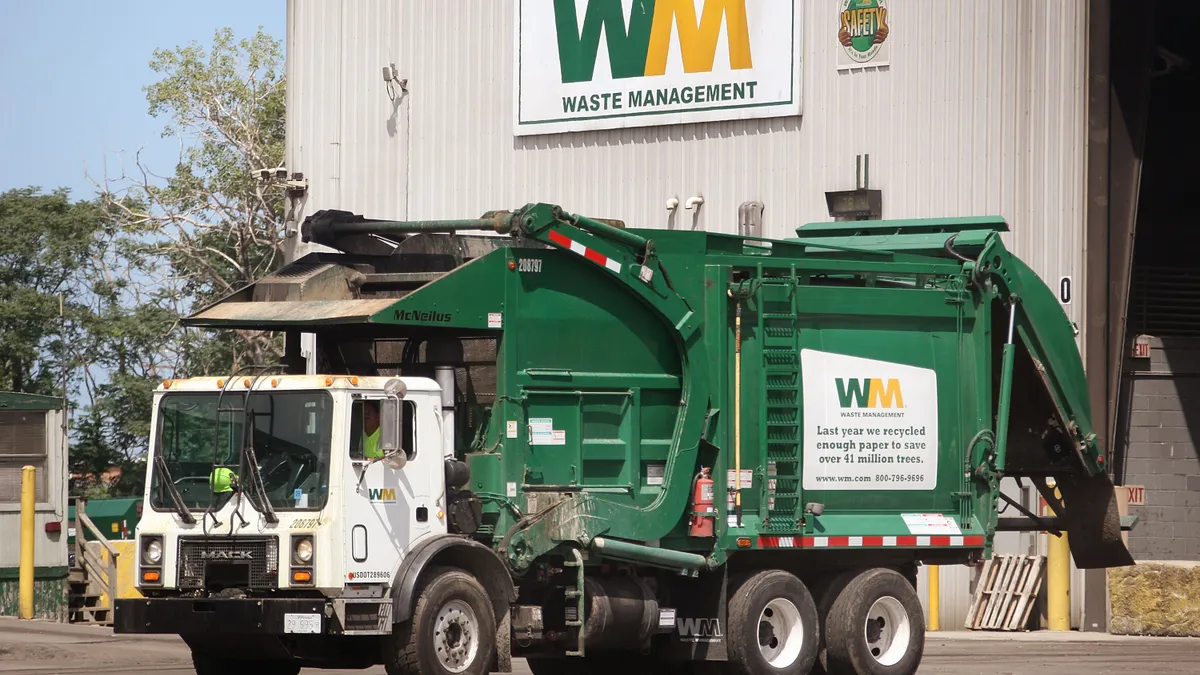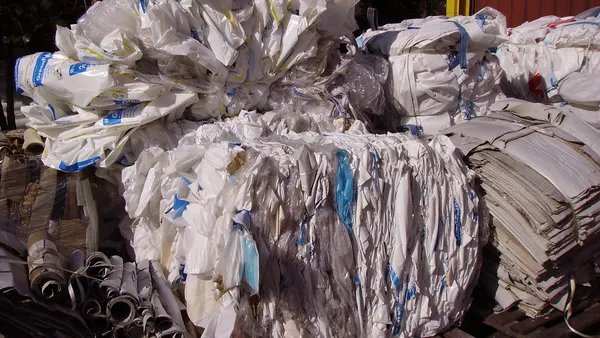A recent report from California’s state recycling commission aims to provide a roadmap for bolstering the state’s recycling system and reversing its declining recycling rates.
The Statewide Commission on Recycling Markets and Curbside Recycling’s report offers 19 policy recommendations meant to help California get back on track with achieving recycling and diversion goals while addressing market development and infrastructure issues. California was not able to achieve its goal to recycle, compost or reduce solid waste by 75% by 2020. California reached a 37% recovery rate in 2019, down from a 40% rate the previous year, according to the commissioners’ report.
The state faces recycling hurdles such as contamination in the recycling stream, a lack of markets for certain material, public confusion over what items can and cannot be recycled in the current systems, and gaps in recycling infrastructure that are costly to fix, said Richard Valle, the commission’s vice chair and CEO of Tri-CED Community Recycling. Individual cities and counties are already working on improving these issues, but “there has to be a system-wide approach to recycling, a statewide approach to recycling. We will never achieve real diversion or impact on the environment (without) a uniform voice.”
The California state legislature mandated state agency CalRecycle to appoint the commission as part of the California Recycling Market Development Act signed into law by Governor Gavin Newsom in 2019. That year's legislative session included several other notable recycling bills, including ones meant to improve market development and commercial recycling access, but its biggest bill, the major extended producer responsibility (EPR) packaging effort SB 54, failed to pass.
Updating the system
The 17-member commission includes representatives from large and small city governments, members of environmental advocacy groups and recycling and waste management businesses such as Recology and Waste Management.
The commission’s report acknowledges that fixing California’s recycling system is a complex, complicated and sometimes messy process that can take time to implement, but there is a sense of urgency around helping lawmakers and decision-makers implement changes that will benefit the environment, Valle said. “California is serious about doing something innovative and different. We won’t be afraid of the truth and the reality that the old system is no longer working.”
Key recommendations from the wide-ranging report call for addressing fires caused by batteries, enacting EPR for hazardous materials, and finding ways to disincentivize or ban the sale of items that cannot be recycled or safely composted.
“If items don’t meet the definition of recyclable or compostable, they shouldn't be sold, or they should have a further review process,” said Heidi Sanborn, the commission’s chair and the executive director of the National Stewardship Action Council.
The commission is working on an additional piece of the report, which will include more comprehensive definitions of what it considers "recyclable and compostable," which it expects to publish by July 1.
The report also recommends strategies for developing better market pull for recycled materials, such as improving California’s State Agency Buy Recycled campaign, refreshing the state market development loan program, and encouraging the use of recycled materials in infrastructure such as rubberized asphalt roads. It also recommends streamlining the state permitting process so large projects have a better chance of being completed, Sanborn added.
One of the report’s major focuses is how to address hazardous items, including lithium-ion batteries. “Batteries are a problem not just because of the heavy metals and chemicals they contain, but if they are compacted by machinery or trash, they can start fires” in recycling facilities and in collection trucks, said Coby Skye, a commissioner and an assistant deputy director for Los Angeles County Public Works.
Batteries also represent another key complication with California’s recycling system: Batteries are more frequently showing up in the waste stream because they are integrated into more and more products. The commission calls for enacting EPR initiatives for batteries and other hazardous items to limit this trend. California already has EPR or product stewardship programs for products such as paints, mattresses, mercury thermostats and pharmaceuticals, Sanborn said.
The report additionally discusses ways to curb the disposal of organics through food waste prevention education, implementing more on-site composting operations and expanding funding for food recovery programs. California is in the process of implementing SB 1383, which establishes a goal to reduce organic waste going to landfills 75% by 2025.
Commissioners also call for more accurate product labeling. Recycling labels can be misleading or incorrect, leading to more contamination in the recycling stream, Skye said. Products might have the word “recyclable” or feature the “chasing arrows” symbol but cannot go in most curbside recycling bins. Plastic bags and batteries are two examples of items that can go to designated take-back facilities or locations, but often end up in the recycling streams instead.
“People think batteries are recyclable, and they definitely are, but people don’t always know the right way to recycle them,” he said.
Influencing policy
Commissioners also examined ways California can limit its export of plastics to other countries in part to prevent illegal dumping and the export of low-grade plastics to countries that may not have the infrastructure to process it, said Skye.
The report calls for local and national leadership to support ratification of the Basel Convention, an international agreement that makes sure certain types of waste are managed, moved and disposed of in an environmentally responsible way. The United States signed but never ratified the Basel Convention, making it one of few countries in the world that is not a party to the agreement.
A 2019 amendment to the Basel Convention added some types of mixed and contaminated plastic shipments to its control procedure as a move to curb plastic pollution. As of Jan. 1, countries cannot trade these materials without a special arrangement. Several U.S. recyclers previously announced they would no longer export these lower-grade plastics.
Recology, which supports calls for the United States to join the Basel Convention, most recently said it will no longer export mixed rigid plastics and mixed #3-7 plastics, according to a statement from Eric Potashner, the company's vice president and senior director of strategic affairs.
Sanborn said the state has already responded to the commission's Basel Convention recommendation. In January, California Assembly member Cristina Garcia and 10 co-sponsors urged President Biden to join the Basel Convention in his first 100 days. “This is an exciting development” that shows legislators are getting on the same page with some of the commission’s recommendations, Sanborn said.
The Basel Convention issue is one example of how the commission sees the report not just as a set of recommendations for California’s lawmakers, but other state or federal decision-makers, she said. Although the report references specific state programs, California is not alone in its market, infrastructure and material flow concerns. “This could have national implications,” said Sanborn.
Some of the recommendations in the commission’s report will require state legislative action, such as steps to sort out the “thorny” issues related to the state’s container recycling program, or bottle bill, Skye said. The bottle bill has been mired in problems such as major closures of beverage container redemption centers, recycling market challenges and arguments over its funding structure.
“It’s tough, because the bottle bill has pieces that dedicate funding to recyclers, local governments, waste haulers – so everyone has a stake, and everyone is afraid that if we overhaul it, their piece might go away,” he said.
Skye anticipates some of the report’s other recommendations might show up in state legislation introduced this year, but said it was too early in the session to name specific bills where proposed recycling solutions could appear.
Despite the pandemic, California’s 2020 legislative session also included significant recycling-related movement. Last year, it became the first in the nation to enact a recycled content requirement for plastic beverage containers. And while the packaging EPR bill failed for the second year in a row, Sanborn said it may not be done forever.
“There’s no telling what will happen in the EPR space,” she said.



















